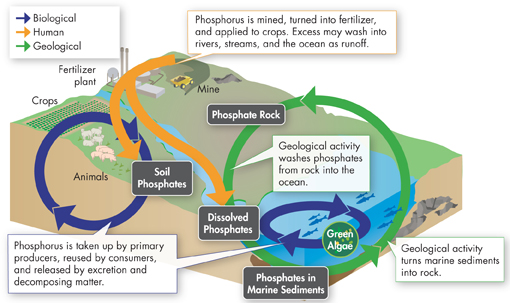
Figure 3–19 The Phosphorus Cycle Phosphorus in the biosphere cycles among the land, ocean sediments, and living organisms. Unlike other nutrients, phosphorus is not found in significant quantities in the atmosphere.
dThe Phosphorus Cycle Phosphorus is essential to living organisms because it forms a part of vital molecules such as DNA and RNA. Although phosphorus is of great biological importance, it is not abundant in the biosphere. Unlike carbon, oxygen, and nitrogen, phosphorus does not enter the atmosphere in significant amounts. Instead, phosphorus in the form of inorganic phosphate remains mostly on land, in the form of phosphate rock and soil minerals, and in the ocean, as dissolved phosphate and phosphate sediments, as seen in Figure 3–19.
As rocks and sediments gradually wear down, phosphate is released. Some phosphate stays on land and cycles between organisms and soil. Plants bind phosphate into organic compounds when they absorb it from soil or water. Organic phosphate moves through the food web, from producers to consumers, and to the rest of the ecosystem. Other phosphate washes into rivers and streams, where it dissolves. This phosphate may eventually makes its way to the ocean, where marine organisms process and incorporate it into biological compounds.
Nutrient Limitation
 How does nutrient availability relate to the primary productivity of an ecosystem?
How does nutrient availability relate to the primary productivity of an ecosystem?
Ecologists are often interested in an ecosystem's primary productivity—the rate at which primary producers create organic material.  If ample sunlight and water are available, the primary productivity of an ecosystem may be limited by the availability of nutrients. If even a single essential nutrient is in short supply, primary productivity will be limited. The nutrient whose supply limits productivity is called the limiting nutrient.
If ample sunlight and water are available, the primary productivity of an ecosystem may be limited by the availability of nutrients. If even a single essential nutrient is in short supply, primary productivity will be limited. The nutrient whose supply limits productivity is called the limiting nutrient.
Table of Contents
- Formulas and Equations
- Applying Formulas and Equations
- Mean, Median, and Mode
- Estimation
- Using Measurements in Calculations
- Effects of Measurement Errors
- Accuracy
- Precision
- Comparing Accuracy and Precision
- Significant Figures
- Calculating With Significant Figures
- Scientific Notation
- Calculating With Scientific Notation
- Dimensional Analysis
- Applying Dimensional Analysis




